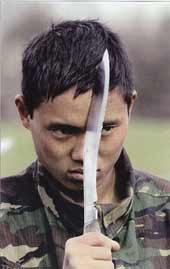An M40 Research Project

| History of the Ghurka
Khukri
An M40 Research Project |
 |
All Text, Graphics, Animations, Video, and Commentary on this website was created by, and is the intellectual property of m4040@m4040.com. All Rights Reserved. Unauthorized reproduction is punishable by up to a $500,000 fine or 5 years imprisonment for a first offense, and up to a $1,000,000 fine or up to 10 years imprisonment for subsequent offenses under the Digital Millenium Copyright Act (DMCA). Requests for use of this material should be forwarded to m4040@m4040.com. Why did I add this disclaimer? SEE WHY.
M40 SURVIVAL KITS ON SALE NOW!
History of the Khukri
The spelling of Khukri has been in dispute for some time. It has been documented as Khookree, Kookerie, Khukri, Khukuri, Kukery, Kukoori, Koukoori, and Kukri. These are mostly from early British accounts. The spoken word is actually 3 syllables: ( koo - ker - ee ). Today's accepted spellings are Kukri or Khukri
As far as I can tell (culled from several historical versions), the present Khukri design found it's origins with the Ghurka tribes in or around the 7th century BC (about 2500 years ago). It may have been a derivative of some of the short swords of the day, either of early Greek design, or of those of the Macedonians who invaded Northwest India around the 4th century BC. The curved design as we know it today, however derived, was born in the hills of Nepal, and it was used for both farming and for battle. Several offshoot designs emerged ranging from smaller versions on the order of 8-10 inches in length, to massive two-handed broadsword versions several feet in length.
The first well-documented (written) accounts of the knife and of the Ghurka tribes come from the British who had taken control of India in the 1800's. The British had been advancing Northward, but suddenly encountered fierce resistance as they advanced into what is modern day Nepal. The Ghurkas not only resisted the British troops, they drove them back. This is something that the British were not at all used to. They called in reinforcements, and then again moved forward. The accounts of what happened are gruesome. The Ghurkas seemed to materialize out of the jungle itself for long enough to cleanly lop a head or limb, and would then disappear before the guns came to bear. The British would set camp for the night, and though they posted sentries, men would die during the night. They were found in the morning with their heads cleanly removed, yet the sentries would not see or hear any intruders. At times the British encountered the Ghurkas in groups. The British soldiers had fine rifles and were the renowned marksmen of the day. The Ghurka were armed only with Khukris, yet were not cowed. Instead they mounted charges, dodging and weaving through the thickets until they were right on top of the British troops. The British went to bayonets, but one account describes the Ghurka tactics as follows:
"When they come near, they suddenly crouch to the ground, drive under the bayonets and strike upward at the men with their knives, ripping them open in a single blow."
The British wisely withdrew from these areas, and then they did something very uncharacteristic. They sent emissaries to make peace with the Ghurka. Treaties were made that had far-reaching consequences. Since that day, the Ghurka have fought alongside British troops in every major engagement, including two world wars, and hundreds of minor skirmishes. In trench warfare against the German forces, the Ghurka performed astounding feats that were legendary for their stealth and courage. They were said to have regularly slipped through German lines, past the sentries, and into the trenches and foxholes. The German forces slept two troops per foxhole. The Ghurka were known to have cut the throat of one man from each foxhole without waking the second man. This was done so that the remaining Germans, upon waking, would find their dead right next to them. Those that were left alive quickly spread the story amongst the rest and, as you can imagine, this type of psychological operation had devastating consequences to the morale of frontline German troops as a whole.
Today, Ghurka warriors stand side-by-side with British troops in Iraq, and the famous Khukri knife is still their fighting knife of choice. In many villages, Ghurka warriors still hand make their own knife, a skill passed from father to son when they reach maturity. To this day, the standard military issue Khukris for Ghurka forces are individually hand made. Making a Khukri is a task that takes four men an entire day. There is no machinery used, and as such, no two Khukris are alike.



It is claimed that a Khukri has never been broken in battle. This is not as surprising as it sounds. The knife in modern times is most often made from leaf springs taken from trucks. It is a full quarter inch in thickness, and is hand hammered to shape over a forge, and carefully hardened along the edge. The high carbon content of the spring steel, when selectively hardened, produces a duality of hardness in the steel, whereby the blade can be flexed without breaking, yet it will take and hold an edge.

The Modern Military Issue Ghurka Khukri - About 18 inches in length, and almost 2 pounds in weight